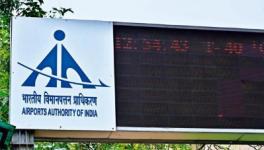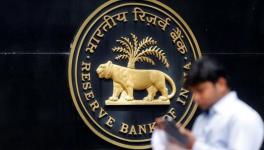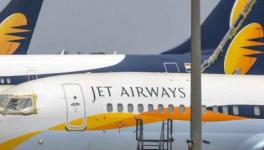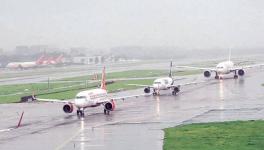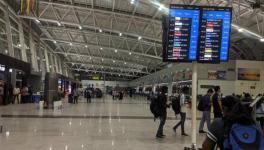Another Airline Takes a Dive in India
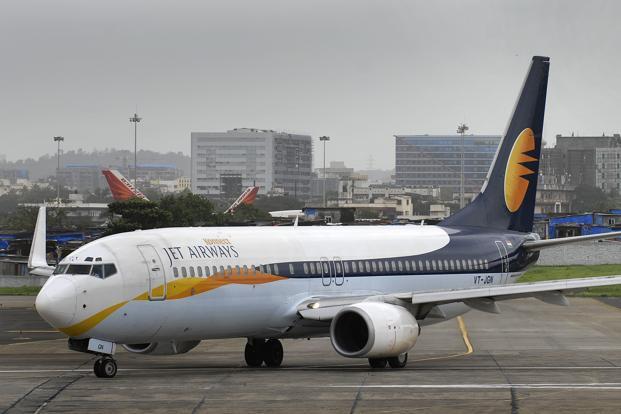
Image Courtesy: Live Mint
It is ironic that in India, the fastest growing air travel market in the world, yet another private airline, this time Jet Airways, collapsed and folded up. However, this should have come as no surprise to anyone following the civil aviation scenario in the country.
As the first private airline in India after the public sector monopoly was ended, Jet was a pioneer, and had a considerable as well as devoted following especially among business travellers who could not stop praising Jet Airways’ service, especially in comparison with what they perceived as the staid and rather cold service from the state-owned carrier. Jet grew rapidly taking advantage of every possible policy or other favour extended to it in the crony capitalist atmosphere prevailing in the early flush of liberalisation and de-regulation of the Indian economy. Jet fought off potential new rivals in full-fare segment as well as the early upstart low-fare and hybrid carriers.
But as new and ambitious low-fare carriers started operating at scale, Jet too joined in a price war that cut fares far below viable levels and created conditions that threatened the very existence of many carriers. Partly out of hubris, partly by taking huge loans from over-obliging banks, and substantially due to its own poor and sometimes sharp business practices, Jet gradually got itself ever deeper in debt, and refused to adopt measures that could have helped it get out of the mess.
An airline industry that resisted reforms and regulations and persisted with flawed business models, a corrupt banking system that gave out huge and imprudent loans, a regulatory system that refused to impose order and colluded with select parties, and a political system whose policies encouraged reckless and unsustainable expansion of air travel, combined to bring about the fall of Jet Airways, and a few other airlines before it, causing the loss of thousands of jobs and the loss of reputation of a sector that was touted as a shining example of the new, prosperous India.
Cronyism
The beginnings and early years of Jet Airways were intertwined with the unfolding neo-liberal paradigm of liberalisation, de-regulation and privatisation in India, and with the ensuing active patronage of and support to the rising class of crony capitalists who were viewed as champions of the new India. Policies were often framed or bent, ostensibly to encourage this or that industry as a whole, but, in practice, favouring one particular company or individual heading it. Public sector firms were hobbled by the new uneven playing field or by deliberate actions to assist their private sector rivals. Petro-chemicals, oil, telecommunication, mining, airlines and many other sectors which had been newly opened up to the private sector, all witnessed these phenomena.
After the private sector was allowed into passenger air services, Jet Airways started in 1994 as an air taxi flying the Mumbai-Ahmedabad business route. The company had been incorporated in 1992, with capital investment by a firm named Tail Winds owned by Naresh Goyal and his two sons, and registered of all places in the Isle of Man. Mann is located in the Irish Sea between England and Ireland and is a self-governing territory that falls in many cracks of the international financial and legal system, is not part of the UK, EU or any other similar entity, and is therefore a haven for all manner of dealings.
Also read: How Modi Bypassed Norms to Try and Enable Adani’s Entry into Airport Business
In the years that followed, it seemed that a strange streak of luck followed Jet Airways. Many new government policies came up which his airline was almost uniquely positioned to take advantage of, each propelling his airline to new heights.
In 1996, when the Tatas sought to start an airline in collaboration with Singapore Airlines, a new rule appeared that while FDI in airlines operating in India were welcome, foreign airlines were not allowed to participate. As a small price to pay for keeping out a potentially formidable rival, Jet Airways dropped Gulf Air and Kuwait Air from its investors. It took 16 long years for this rather incongruous policy to be revised and, in 2016, foreign airlines were permitted to hold up to 49% share in “existing” airlines. The policy, quite strangely, also specifically allowed 100% holdings by Non-Resident Indians (NRIs), in which category only Naresh Goyal’s Jet Airways fell! The policy came a few years too late for Kingfisher, and may have provided another escape option for that indebted carrier too. Although, it is anyone’s guess whether the ego-driven Vijay Mallya would have actually parted with a substantial stake in his airline. In any case, the new policy frame enabled Jet Airways to bring in Etihad Airways as a partner with 24% holdings.
Such cases occur with remarkable consistency throughout Jet Airways’ history. In 1998, when Jet introduced the 72-seater turbo-prop ATR-72 for shorter routes, the government waived landing and parking charges for aircraft with less than 80 seats. Again, in 2004 when the new private airlines were clamouring for permission to start flying overseas, government came up with the so-called 5/20 rule which stipulated that an airline must have been operating for at least five years and must have a fleet of at least 20 aircraft for it to be entitled to international routes. Jet met this criterion easily, but other carriers struggled or were left out. It took till 2016 for this rule to change.
And even at the very end, when Jet’s loan defaults became a recurrent feature, Jet was given ample time to look around for potential investors, and insolvency proceedings were not commenced as soon as required. At election time, the government did not want a messy bankruptcy on its hands. On their part, banks were willing to oblige and hoped that the situation would somehow resolve itself, although most observers could not see a way out. Finally, when Jet went belly-up, the employees were left empty-handed, the banks sat on their hands, and Naresh Goyal simply went away quietly. It is not surprising that Vijay Mallya, staring at deportation from the UK and jail time back in India, is complaining loudly at the seemingly differential treatment.
Failed Model
Much of Jet’s travails were also due to failed models of air travel in India. This statement may cause some surprise, since international aviation circles, consultancy organisations and business papers have for so long been singing the praises of booming air passenger traffic in India, registering clear 10% or more annual rates of growth for over a decade, even touching 20% many years. Airports in major Indian metropolitan or major cities, even greenfield or upgraded ones, are poised to exceed their planned capacities making expansion or second airports a necessity. But these bald numbers conceal deep underlying frailties.
In the first place, the term low-cost carriers applied to the no-frills airlines which are today’s market leaders, is a misnomer. They should really be called low-fare airlines. These airlines use the same airports and terminals as the full-service carriers, pay more or less the same landing and parking charges, and pay pilots market rates. In Europe, for example, low-cost carriers use airports further away from major cities and where they are charged less, provide much less amenities, and charge for everything, sometimes even more use of bathrooms! They economise essentially on consumables and overheads, lower wage bills for cabin crew and by charging for reservation of seats and for food. With costs being not too much lower than that of full-service carriers, the low-fare carriers make up with higher capacity utilisation, higher seat density, and single-class cabins.
Also read: The Jet Airways Crisis Sheds A Stark Light On India’s Aviation Market
In the cut-throat competition for passengers, full-service carriers have over the years been forced to lower their economy class fares to levels close to that of low-fare carriers. But they also have business class sections, in which seat density and capacity utilisation is much lower, insufficient to adequately compensate for the relatively lower fares they are forced to levy. The only plus points of full-service carriers is their “free” food which is actually factored into their higher fares, on-board newspapers and blankets, and the offer of lounge services on payment. However, most full-service carriers have higher costs because they want to live up to an image of superior service, spend more on cabin crew and livery, and other nuances which most customers are quite happy to do without if they can save a few hundred rupees. Jet Airways, for instance, spent approximately 1.5 times of what low-fare carriers typically spend per passenger, but cannot charge 1.5 times the fare! Kingfisher was famous for fancy interiors, gifts to passengers, and a luxury image. No wonder they went bust!
The fact is that even among air passengers, India is a highly price-sensitive market and the size of the middle class is not as large as is commonly imagined or projected by international consultancies interested in drumming up more investment, and as directly experienced by many an MNC. In order to cater to this market, and expand, all operators led by the low-fare carriers have engaged in a price war, a race to the bottom if you will, where margins are paper thin and where negative balancesheets are only an air pocket away. And this, at a time when fuel prices amounting to 40-50% of costs are high, aided by high domestic taxes, and valuation of the rupee has been taking a hit. Most airlines are on the verge of going into the red, and the full-service carriers are the most vulnerable. Jet Airways were in the red for most years in the past decade, Sahara could not take the heat, and Deccan Airways got out at the right time. Consolidation provided a temporary reprieve, but the same reality caught up with the survivors who then faced the same fate.
Most of the profitable routes are between the metros, and between some big cities and the metros. Yet as demand and competition increase, other routes too must be catered to and lower capacity utilisation has to be factored in to already thin margins.
Fact is that the present low air fares are unsustainable. Airlines could sit down with regulators and rationalise fares, but successive governments have shied away from this option for fear of lower passenger growth rates and the “message” that would send. Making flying possible for “the common man” has become popular, but highly unrealistic slogan.
The present government’s UDAN (Uday Desh ka Aam Nagrik or The Country’s Common Man will Fly) scheme for regional connectivity is a case in point. Unused, underserved or even new regional airports will be funded, and upto 50% of seats will be provided “viability gap funding”, another term for subsidy, which is, however, considered a dirty word when it comes to public education, health or civic services. This is a clear acknowledgement of the limits to air passenger growth, and to the low fares that the Indian middle class can bear in reality.
Air travel in India is desperately in need of reform, and realism. But who is going to bell the cat, who is going to bust the myth of a high flying India? If the government does not, then more airlines will go under. For sure.
Also read: Union Threatens Industrial Action Over Jet Airways Issue
Get the latest reports & analysis with people's perspective on Protests, movements & deep analytical videos, discussions of the current affairs in your Telegram app. Subscribe to NewsClick's Telegram channel & get Real-Time updates on stories, as they get published on our website.












